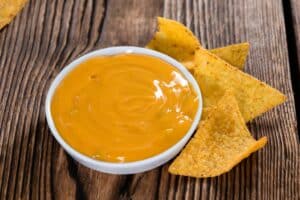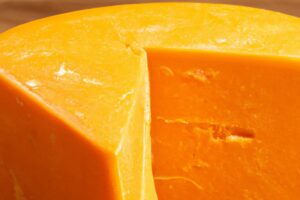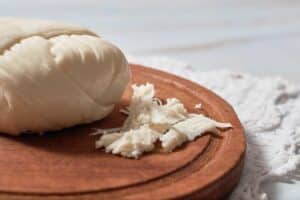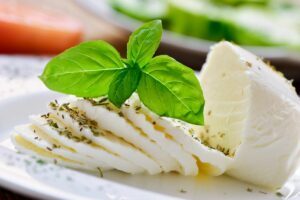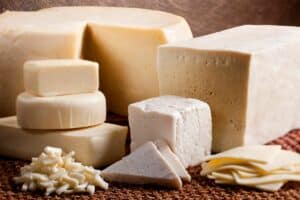Paneer is a protein and calcium-rich cheese from India with a mild flavor. When selecting our recommendations for paneer cheese alternatives, we kept these factors in mind, as well as potential availability.
We analyzed dietary restrictions and paneer’s role in various dishes, and we outlined these considerations so you can make the best decision for which paneer alternative is best for you!
What is Paneer Cheese?
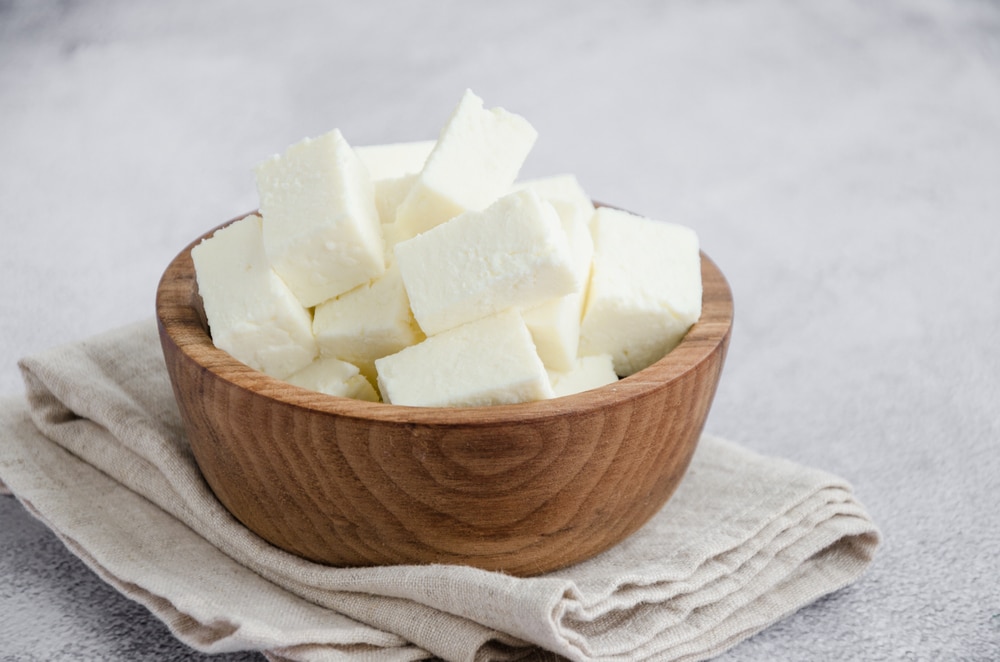
Paneer is a fresh, white cheese with a firm and crumbly, chewy texture and a milky flavor that has recorded history going back 8000 years!
Despite its firmness, it’s a soft cheese that doesn’t melt. Because it doesn’t melt, one delicious way to enjoy this simple cheese is seasoned and fried or grilled. Paneer is traditionally used in everything from soups and salads to curries and sandwiches.
Paneer typically has roughly 14-25 grams of protein per 100-gram serving, making a serving of paneer cheese as high in protein as two-three eggs. Paneer also provides 33% of the recommended daily value of calcium!
Dietary Restrictions and Paneer
Unlike firm cheeses which are commonly made with rennet, paneer is made by adding acid, like lemon juice, to hot milk, causing curds to form. Because it isn’t made with rennet, it’s naturally vegetarian and halal and can be made Kosher.
Since it is made with buffalo milk, cow milk, or a blend of the two, paneer is not vegan (but we will be covering a vegan option in this article!).
5 Recommended Paneer Cheese Substitute
The 5 most common cheese like paneer cheese:
- Halloumi Cheese
- Panela
- Fresh, well drained Ricotta
- Feta Cheese
- Extra-firm Tofu
Halloumi Cheese
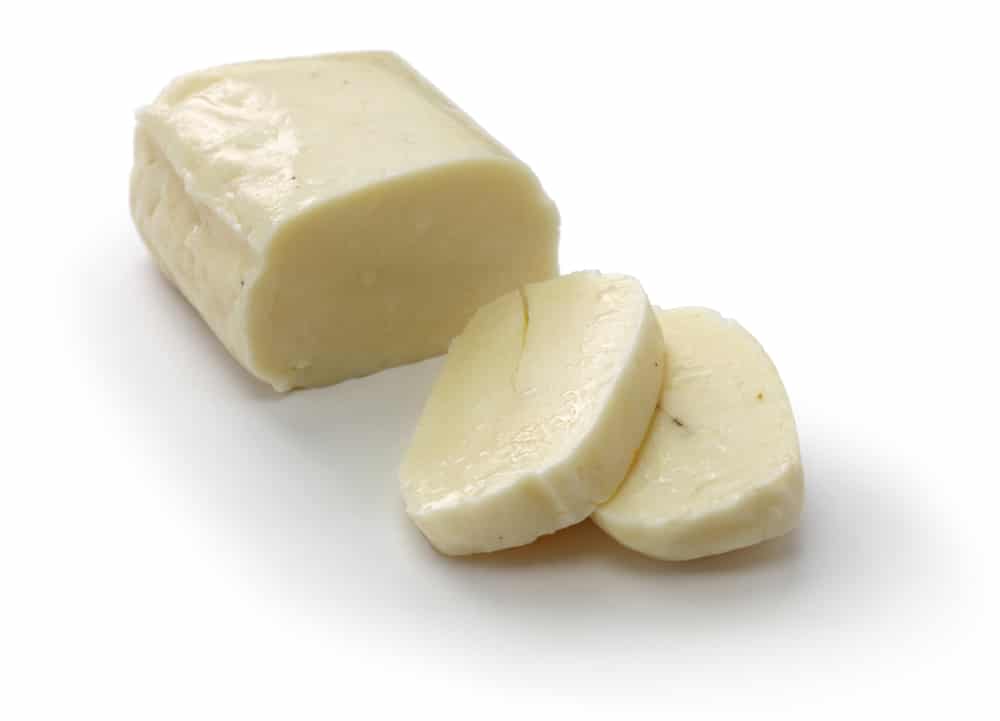
Halloumi is a semi-soft white cheese with a creamy texture and a salty, tangy flavor. It’s not unlike a brined feta.
What’s Similar?
Like paneer, halloumi is firm and chewy, with a high melting point that makes it great for frying or grilling. Cooking it tones down the saltiness, aligning it more closely with the paneer flavor palette. It has around 25 grams of protein per 100-gram serving and has almost 70% of the recommended daily value of calcium!
What’s Different?
Halloumi is made without acids; essentially the opposite way paneer is made. Its texture is more chewy and springy than paneer, and its salty, tangy, and savory flavor makes it more intense and robust than paneer. Some describe it as meaty in taste and texture. It is made from cow, sheep, or goat’s milk as a Cypriot cheese.
Dietary Restrictions
Halloumi is made with rennet, so it is only vegetarian if made with vegetarian rennet, and it is only halal if made with halal or vegetarian rennet. You can find Kosher options. You won’t be able to find halloumi at most grocery stores, but specialty grocers like Sprout’s, Trader Joe’s, and your local Middle Eastern and Mediterranean markets should carry it.
How to Substitute Halloumi Cheese for Paneer
You can replace Paneer with an equal amount of Halloumi in most recipes. The only significant difference will be with the flavor, resulting in a more savory, rich flavor than a dish made with paneer.
Panela Cheese
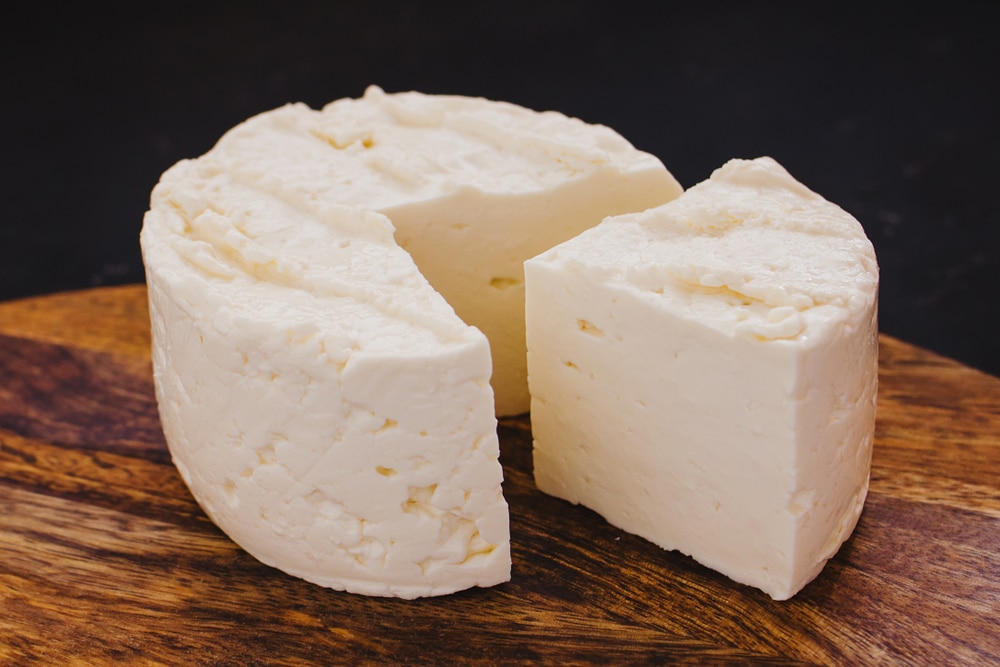
Queso Panela (also known as queso canasta or queso de la canasta) is a fresh, firm white cheese from Mexico.
What’s Similar?
It has a creamy, milky, and mild flavor similar to paneer. Like paneer cheese, it softens when heated but doesn’t melt. It can be crumbled or chopped to suit your recipe’s needs.
Panela has roughly 21 grams of protein per 100-gram serving, making it a great option to replace paneer if you want to keep the protein high. The same serving size also has around 40% of your daily recommended calcium, making it slightly more calcium-rich than paneer.
What’s Different?
Panela is made with rennet.
Dietary Restrictions
Since it is made with rennet, vegetarian panela will need to be made with vegetarian rennet, and halal panela will need vegetarian or halal rennet. We found no evidence of Kosher panela on the market.
How to Substitute Panela Cheese for Paneer
This paneer alternative is excellent for soups, curries, sandwiches, and salads. Replace the required paneer with the same quantity of panela cheese, chopped, sliced, or crumbled as the recipe calls for. Of the substitutes for paneer, panela is the closest and should work well in most recipes.
Fresh, Well Drained Ricotta
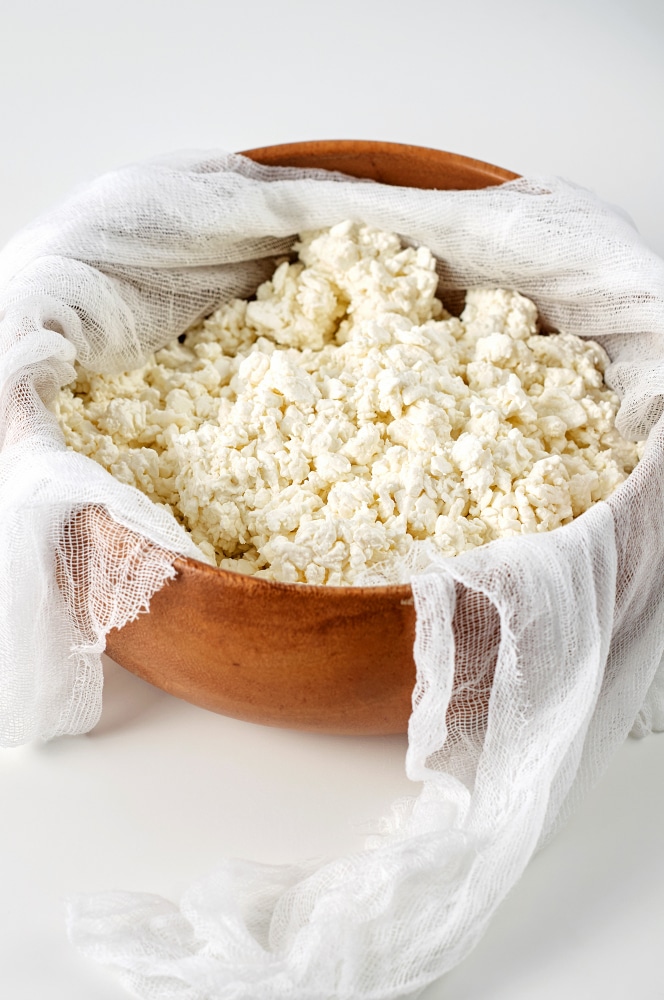
Ricotta is a fresh, soft white cheese from Italy.
What’s Similar?
Ricotta has a creamy, milky flavor and a creamy texture.
What’s Different?
Ricotta has a natural sweetness and a fluffy and grainy texture, unlike paneer. A 100-gram serving of fresh ricotta only has around ten grams of protein per serving, making it a far less filling substitute for paneer. It also only has 10% of your daily recommended value of calcium. Ricotta has less than half the fat of paneer.
Dietary Restrictions
Ricotta isn’t made with rennet, so it is naturally vegetarian and halal. Kosher options are available. You should easily find ricotta in a grocery store near you.
How to Substitute Fresh Ricotta for Paneer
You can substitute an equal amount of ricotta for paneer. Drain well and consider straining it firmly through a cheesecloth. Fresh ricotta is best for dishes that call for crumbled paneer, and we don’t recommend it for soups or curries.
Can’t find ricotta but need something with similar taste? See popular cheese like ricotta.
Feta Cheese
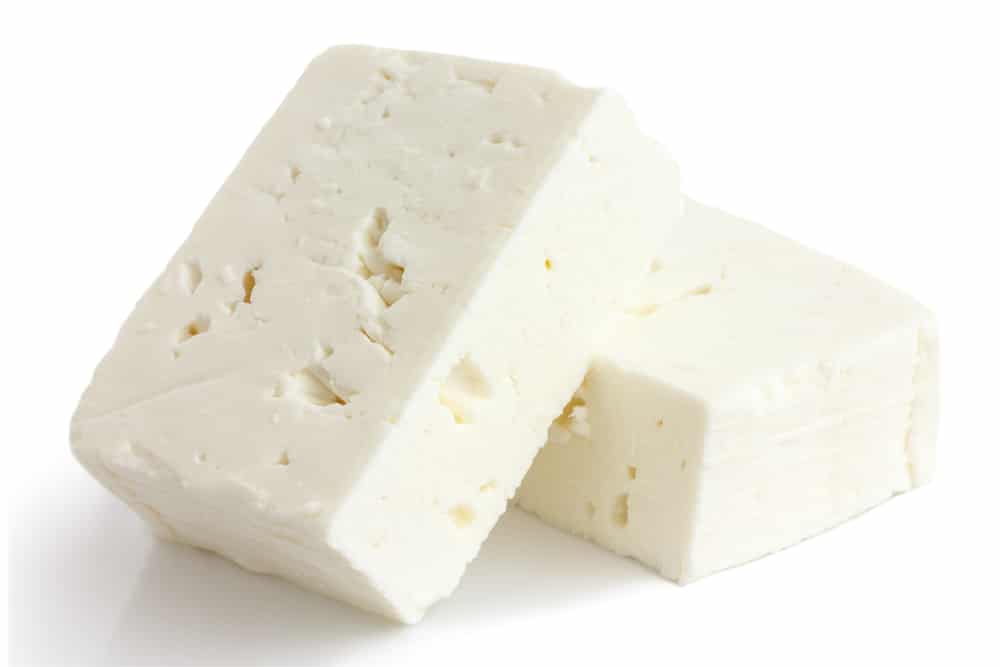
Feta is a soft, white brined cheese from the Mediterranean. It’s such a central part of Greek cuisine that the EU has given it protected status, so only feta made in Greece is considered feta in Europe!
What’s Similar?
Feta cheese has a crumbly, creamy texture that works well in salads and as a topping. It doesn’t melt when heated, but it softens and gets gooey. Like paneer, this is because of its high acid levels. Feta has a similar fat content to paneer.
What’s Different?
Feta is traditionally made from a mix of goat and sheep milk, but varieties exist that are made with only one of these or cow milk. It’s robust and full-flavored, with a tangy and salty edge from the brine. Feta cheese has a grainy and open texture that makes it more accepting of crumbling than slicing. It has around 10 grams less protein than paneer per 100-gram serving.
Dietary Restrictions
Feta cheese is made with rennet. Vegetarian options will be made with vegetarian rennet, as will halal versions unless they are made with rennet sourced from a halal butcher. Kosher feta cheese options can be found. You should be able to find feta at a local grocery store.
How to Substitute Feta Cheese for Paneer
Its rich flavor makes feta an ideal substitute for paneer in dishes you want to intensify with its briny bite. Because it doesn’t melt like other paneer cheese alternatives we’ve discussed, you can easily use it in place of paneer in curries and soups. Replace crumbled paneer with an equal amount of crumbled feta cheese.
Extra-Firm Tofu
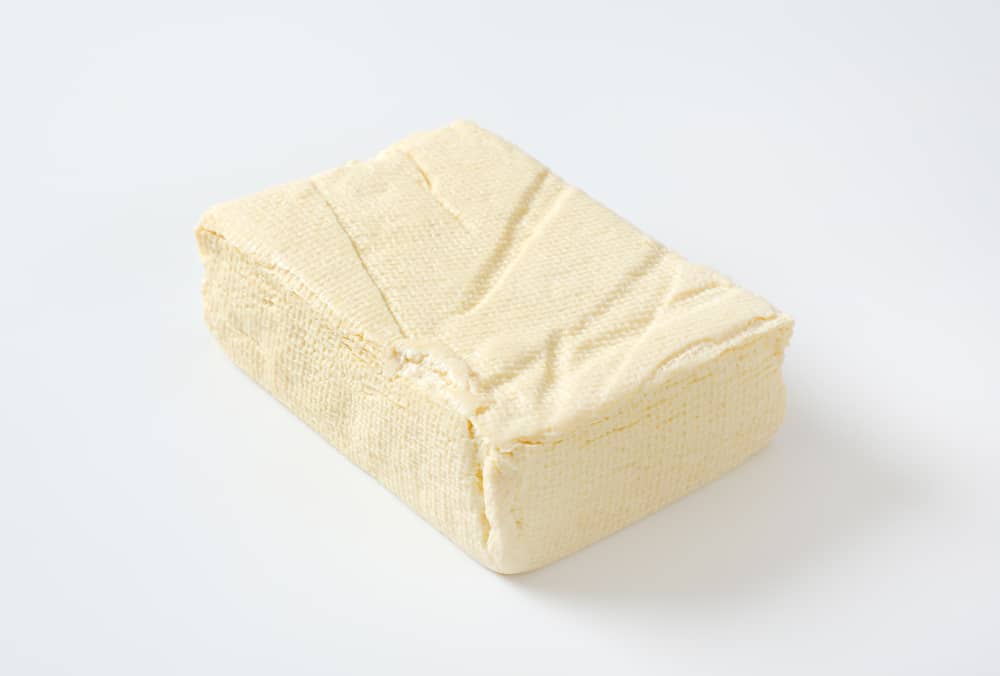
Extra-firm tofu is a form of tofu, a curd produced from soy milk, which is exceptionally dense and compact for a thick texture. It’s believed to have been invented during China’s Han dynasty and is now a significant protein source in numerous Southeast Asian countries.
What’s Similar?
It has a mild flavor and firm texture, which handles crumbling, slicing, and chopping well and beautifully mimics paneer cheese. Its flavor is closest to paneer when it has been cooked. Much like paneer, tofu doesn’t melt when heated.
What’s Different?
Tofu isn’t a cheese and doesn’t soften much when cooked. It has less protein than paneer, with only 17 or so grams per 100-gram serving. But, tofu has more calcium, with a whopping 53% of your recommended daily value! It’s also a better source of iron and potassium, with roughly a third less fat.
This is an excellent alternative to paneer if you’re looking for a more rounded source of nutrients.
Dietary Restrictions
Tofu is naturally vegan, vegetarian, halal, and kosher. You should be able to find it prepackaged in the grocery section of your favorite grocery store, but you may be able to find it fresh at your local Asian market.
How to Substitute Extra-Firm Tofu for Paneer
It’s an incredibly versatile paneer replacement since it holds its shape well in soups and curries, and it can withstand frying. To use it, drain your tofu and gently squeeze it to remove any excess fluid. Then treat your tofu the way you would your paneer, and use an equal amount to replace the paneer in your recipe.

